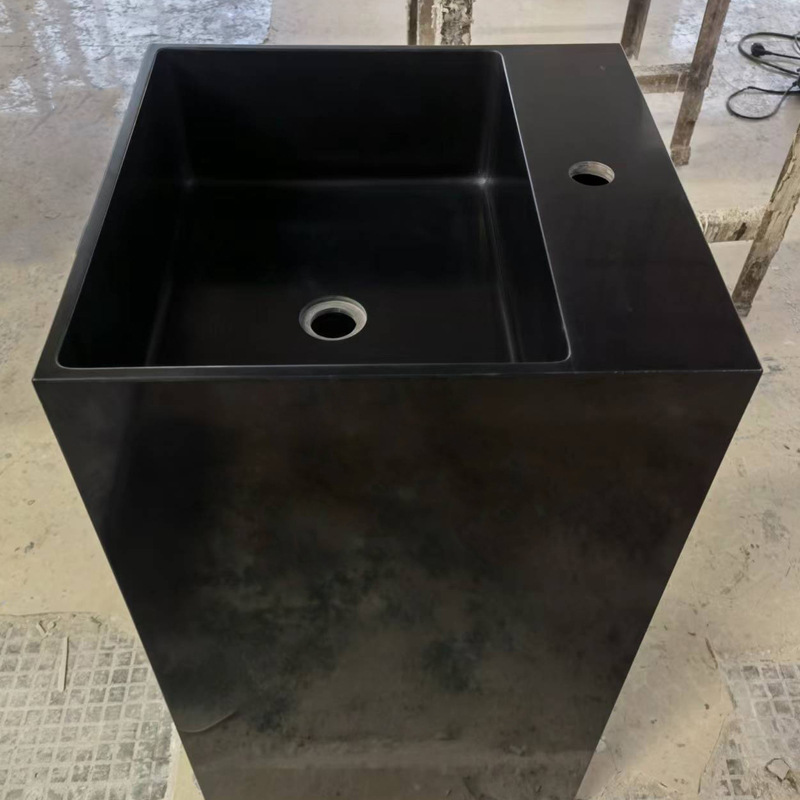
Solid Surface Sinks are a popular choice for modern kitchens and bathrooms due to their durability, aesthetic appeal, and ease of maintenance. These sinks are made from a non-porous blend of acrylic, polyester resins, and natural minerals, which makes them resistant to stains, moisture, and bacterial growth. However, like any material, Solid Surface Sinks require proper care to keep them looking new and functioning well for years. In this article, we’ll discuss simple cleaning routines, tips to prevent damage, and repair options for Solid Surface Sinks.

The beauty of Solid Surface Sinks lies not only in their seamless, smooth finish but also in their ease of cleaning. Here’s a simple routine to maintain the cleanliness and shine of your solid surface sink:
Daily Cleaning:
Use mild soap and water: For routine cleaning, simply wipe the sink with a soft cloth or sponge using a mild dish soap and warm water. This will help remove any soap residue, food particles, or stains.
Avoid harsh abrasives: Never use abrasive cleaners or scouring pads, as they can scratch the surface. Instead, opt for a soft microfiber cloth, a non-abrasive sponge, or a gentle nylon brush.
Dry the Sink:
After cleaning, wipe the sink dry with a soft towel to avoid water spots and streaks. This will help maintain the glossy finish of the sink and prevent mineral deposits from accumulating.
Weekly Deep Cleaning:
Use a non-abrasive cleaner: For a deeper clean once a week, use a non-abrasive solid surface cleaner or a diluted solution of vinegar and water (1 part vinegar to 10 parts water). Apply it to the surface and use a soft cloth to scrub the sink gently.
Clean the drain area: Don't forget to clean around the drain and faucet area, as these spots can accumulate grime and soap scum. Use a toothbrush to gently scrub hard-to-reach areas.
One of the biggest advantages of solid surface sinks is their resistance to stains and discoloration. However, like any material, they are not completely impervious to damage. Here are some tips to keep your sink looking pristine:
Prevent Scratches:
Use a cutting board: To prevent scratches from knives or other sharp objects, always use a cutting board when preparing food. Solid surface sinks can be scratched by rough or sharp items, so it’s essential to be mindful when placing utensils or cookware in the sink.
Avoid dragging heavy objects: When moving pots, pans, or heavy dishes, lift them instead of dragging them across the sink. The friction from dragging heavy items can cause surface damage.
Prevent Stains:
Wipe up spills promptly: Solid surface sinks are resistant to most stains, but it’s still a good idea to wipe up spills, especially from substances like coffee, tea, or red wine, right away. This will prevent any potential staining over time.
Avoid harsh chemicals: Strong chemicals like bleach or harsh cleaning products can cause discoloration or dullness on the surface of your sink. Stick to mild, non-abrasive cleaners.
Prevent Discoloration:
Use a sink mat or grid: If you’re concerned about discoloration from frequent use, consider placing a sink mat or grid at the bottom of the sink. This helps protect the sink from heavy cookware and ensures that it stays free of scratches or discoloration from metal objects.
Regular polishing: Occasionally, you may want to polish your solid surface sink using a specialized polish or a recommended solid surface care product. This will help restore its shine and keep it looking new.
While solid surface sinks are known for their durability, minor damage like scratches, chips, or discoloration may still occur. The good news is that solid surface sinks are relatively easy to repair. Here’s what you can do:
Minor Scratches:
Buffing out scratches: For light surface scratches, you can often buff them out yourself. Use a fine-grit sandpaper (usually around 400-600 grit) to lightly sand the scratched area in a circular motion. Afterward, use a damp cloth to wipe the area clean, and finish with a buffing pad or a soft microfiber cloth to restore the shine.
Use a solid surface polish: Some solid surface sink manufacturers offer special polishes designed to restore the finish of your sink. Applying this polish with a soft cloth can help reduce the visibility of minor scratches and maintain the glossy appearance.
Chips or Cracks:
Professional repair: While small chips can often be repaired at home with epoxy resin or a solid surface repair kit, larger cracks or chips may require professional repair. Most solid surface sink manufacturers or specialists offer repair services where they can seamlessly fill in the damage and restore the sink to its original condition.
DIY repair kits: For small chips, you can purchase repair kits from home improvement stores or online. These kits usually contain color-matching compounds that can fill in small chips and cracks. Follow the instructions carefully, and make sure to smooth out the repaired area for a seamless finish.
Stubborn Stains or Discoloration:
Use a deep cleaning paste: For stubborn stains or discoloration, create a paste using baking soda and water. Apply the paste to the stained area, let it sit for 15-20 minutes, and then scrub gently with a soft cloth or sponge.
Re-polishing the surface: After dealing with stains or discoloration, you can also re-polish the entire sink using an appropriate solid surface polish to restore its smooth, glossy finish.
With regular maintenance and care, your solid surface sink can continue to look beautiful and function well for many years. Simple cleaning routines, preventive measures to avoid scratches and stains, and knowing how to repair minor damage are all essential steps in preserving the longevity of your sink. By following these easy maintenance tips, you can ensure that your solid surface sink remains an attractive and functional part of your kitchen or bathroom for years to come.